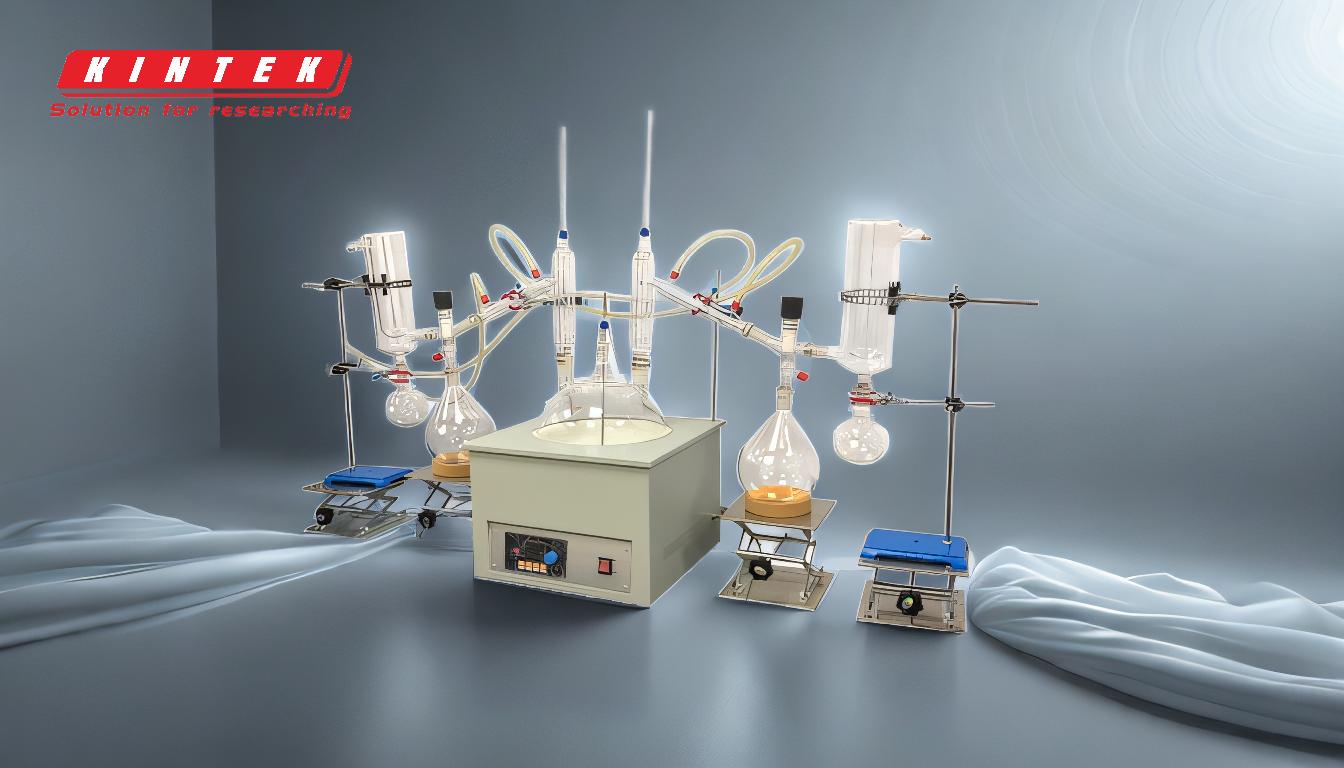Short-path distillation and normal (conventional) distillation are both techniques used to separate and purify compounds based on differences in volatility. However, they differ significantly in terms of equipment, operating conditions, efficiency, and applications. Short-path distillation is a compact, low-pressure method that operates under vacuum, reducing boiling points and enabling faster, more efficient separation of compounds, especially heavier or heat-sensitive ones. It requires smaller apparatus, achieves high purity levels (up to 99%), and is ideal for laboratory settings with limited space. In contrast, normal distillation typically involves larger equipment, operates at atmospheric pressure, and is better suited for simpler separations or industrial-scale processes. Short-path distillation also minimizes waste, reduces operating temperatures, and completes separations in seconds, whereas conventional methods may take hours.
Key Points Explained:

-
Operating Pressure and Temperature:
- Short-Path Distillation: Operates under low pressure (vacuum), which significantly reduces the boiling points of compounds. This allows for the distillation of heavier or heat-sensitive materials at lower temperatures, minimizing thermal degradation.
- Normal Distillation: Operates at atmospheric pressure, requiring higher temperatures to achieve boiling points. This can be less suitable for heat-sensitive compounds and may lead to thermal decomposition.
-
Equipment Size and Complexity:
- Short-Path Distillation: Uses compact, smaller apparatus with a minimal instrumentation footprint. It is designed for laboratory-scale applications where space is limited.
- Normal Distillation: Typically involves larger, more complex equipment, making it better suited for industrial-scale processes or simpler separations.
-
Efficiency and Speed:
- Short-Path Distillation: Achieves faster separations, often completing the process in seconds. This is due to the reduced boiling points under vacuum and the short distance between the evaporator and condenser.
- Normal Distillation: Generally takes longer, sometimes hours, due to the need to heat materials to their boiling points at atmospheric pressure and the longer path for vapor travel.
-
Purity Levels:
- Short-Path Distillation: Can achieve distillate purity levels of up to 99%, making it highly effective for purifying compounds.
- Normal Distillation: Purity levels are often lower, depending on the complexity of the mixture and the efficiency of the distillation setup.
-
Applications:
- Short-Path Distillation: Ideal for laboratory applications, especially for heat-sensitive or high-boiling-point compounds. It is also used in industries requiring high-purity materials, such as pharmaceuticals and essential oils.
- Normal Distillation: Commonly used for simpler separations, such as purifying water or separating alcohol from water, and is more prevalent in industrial settings.
-
Cost and Waste Reduction:
- Short-Path Distillation: Reduces waste and operating costs by requiring less heat and time. It also minimizes the risk of spillage or worker exposure to hazardous materials due to its low-pressure operation.
- Normal Distillation: May generate more waste and require higher energy consumption, especially for complex separations or large-scale processes.
-
Versatility:
- Short-Path Distillation: Suitable for a wider range of materials, including those with high boiling points or thermal sensitivity.
- Normal Distillation: Limited to specific materials and less effective for complex or heat-sensitive mixtures.
In summary, short-path distillation offers significant advantages over normal distillation in terms of efficiency, purity, and suitability for heat-sensitive compounds. Its compact design and low-pressure operation make it a preferred choice for laboratory and high-purity applications, while normal distillation remains a practical option for simpler, large-scale separations.
Summary Table:
| Aspect | Short-Path Distillation | Normal Distillation |
|---|---|---|
| Operating Pressure | Low pressure (vacuum) | Atmospheric pressure |
| Temperature | Lower temperatures, minimizes thermal degradation | Higher temperatures, may cause thermal decomposition |
| Equipment Size | Compact, smaller apparatus | Larger, more complex equipment |
| Efficiency and Speed | Faster separations (seconds) | Slower separations (hours) |
| Purity Levels | Up to 99% purity | Lower purity levels |
| Applications | Ideal for heat-sensitive or high-boiling-point compounds (e.g., pharmaceuticals, essential oils) | Suitable for simpler separations (e.g., water purification, alcohol separation) |
| Cost and Waste Reduction | Reduces waste and operating costs | Higher waste and energy consumption |
| Versatility | Suitable for a wider range of materials | Limited to specific materials |
Need help choosing the right distillation method for your application? Contact our experts today!











